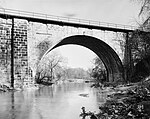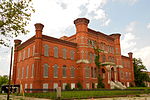The Cardinal Gibbons School, also referred to as Cardinal Gibbons, CG, and most commonly as Gibbons, was a Roman Catholic high school and middle school for boys in Baltimore, Maryland, USA. A private institution for grades 6–12, Gibbons drew its enrollment from the neighborhoods of southwest Baltimore City and the counties surrounding the Baltimore metropolitan area, with some as far away as Harford County, Carroll County, and Frederick County.
Named in honor of James Cardinal Gibbons, said to be Baltimore's most distinguished Catholic churchman, the school was established in 1962 by the Archdiocese of Baltimore. Gibbons occupied the former site of the St. Mary's Industrial School, a reform school for boys and the Alma Mater of baseball great George Herman "Babe" Ruth. Following extensive renovations of the old St. Mary's campus in the early 1960s, the Cardinal Gibbons School opened. The school grew to its peak enrollment of just over 1,000 students in the mid-1970s. In 1988, the school expanded its academic programs with the addition of a middle school. The middle school program ceased operation following the 2009 academic school year. The school closed after the end of the 2009–2010 school year due to declining enrollment and financial problems in the Archdiocese, Organizations were established to make attempts to reopen the school, but the school did not reopen. The grounds are not used for academics, although local schools and sport programs have made use of the athletic facilities. In 2012, neighboring St. Agnes Hospital purchased the old Gibbons property with plans to incorporate the old campus into its growing medical facilities, named the Gibbons Commons.
Gibbons was a college preparatory middle and high school, with core curriculum courses in literature, religious studies, mathematics, laboratory science, social sciences and history, fine arts, physical education, technology, and foreign language. Gibbons offered a variety of Advanced Placement courses, including joint courses with neighboring all-girls high school Seton Keough to the south. Gibbons also offered dual enrollment courses in conjunction with the Community College of Baltimore County. All students at Gibbons were held to academic integrity through the use of an honor code.
There was a long-standing rivalry between Cardinal Gibbons and nearby high school Mount Saint Joseph in the Irvington neighborhood of southwest Baltimore. Due to their close proximity and frequent meetings in playoffs and tournaments in basketball, the rivalry intensified as the Gibbons' basketball program established itself as a championship program in the 1970s. The rivalry grew to include other sports and academics as well.







